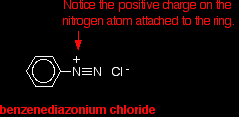MAKING DIAZONIUM SALTS FROM PHENYLAMINEThis page looks at the reaction between phenylamine (also known as aniline and aminobenzene) and nitrous acid - particularly its reaction at temperatures of less than 5°C to produce diazonium salts. If you want to know about the reactions of the diazonium ions formed, you will find a link at the bottom of the page. The reactions of phenylamine with nitrous acidNitrous acid (also known as nitric(III) acid) has the formula HNO2. It is sometimes written as HONO to show the way it is joined up. Nitrous acid decomposes very readily and is always made in situ. In the case of its reaction with phenylamine, the phenylamine is first dissolved in hydrochloric acid, and then a solution of sodium or potassium nitrite is added. The reaction between the hydrochloric acid and the nitrite ions produces the nitrous acid. You get the reaction:
Because nitrous acid is a weak acid, the position of equilibrium lies well the right. Phenylamine reacts with nitrous acid differently depending on the temperature. The reaction on warming If the mixture is warmed, you get a black oily product which contains phenol (amongst other things), and nitrogen gas is given off.
|
|
|
Note: This is similar to the reaction between aliphatic primary amines and nitrous acid. Use the BACK button on your browser to return to this page later if you choose to follow this link. The explanation for the reaction (including the reason why there is a different reaction in the hot or cold) can be found on the page about reactions of diazonium ions (link at the bottom of this page). |
|
The reaction at low temperatures The solution of phenylamine in hydrochloric acid (phenylammonium chloride solution) is stood in a beaker of ice. The sodium or potassium nitrite solution is also cooled in the ice. The solution of the nitrite is then added very slowly to the phenylammonium chloride solution - so that the temperature never goes above 5°C. You end up with a solution containing benzenediazonium chloride:
The positive ion, containing the -N2+ group, is known as a diazonium ion. The "azo" bit of the name refers to nitrogen. |
|
|
Note: I've drawn the diazonium ion with the -N2+ group at the side for two reasons. First, because it is easier to show that the benzene ring and the two nitrogen atoms lie in a straight line. Secondly, because that's the way I shall need to draw it in some of its reactions to make certain structures clear. |
|
The ionic equation for the reaction is:
Notice that the chloride ions from the acid aren't involved in this in any way. If you use hydrochloric acid, the solution will contain benzenediazonium chloride. If you used a different acid, you would just get a different salt - a sulphate or hydrogensulphate, for example, if you used sulphuric acid. The reactions of a diazonium salt are always done with a freshly prepared solution made in this way. The solutions don't keep. Diazonium salts are very unstable and tend to be explosive as solids.
|
|

